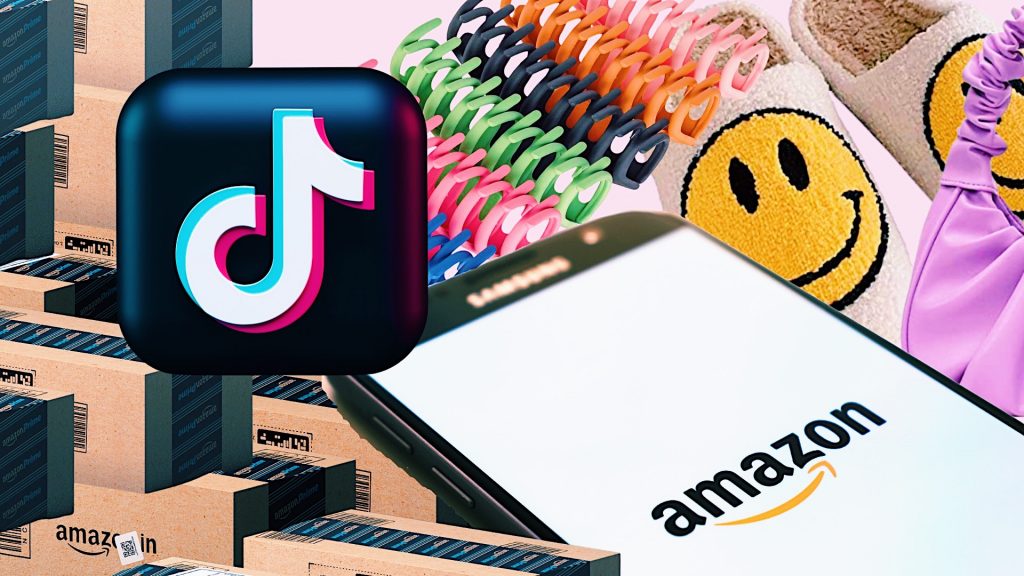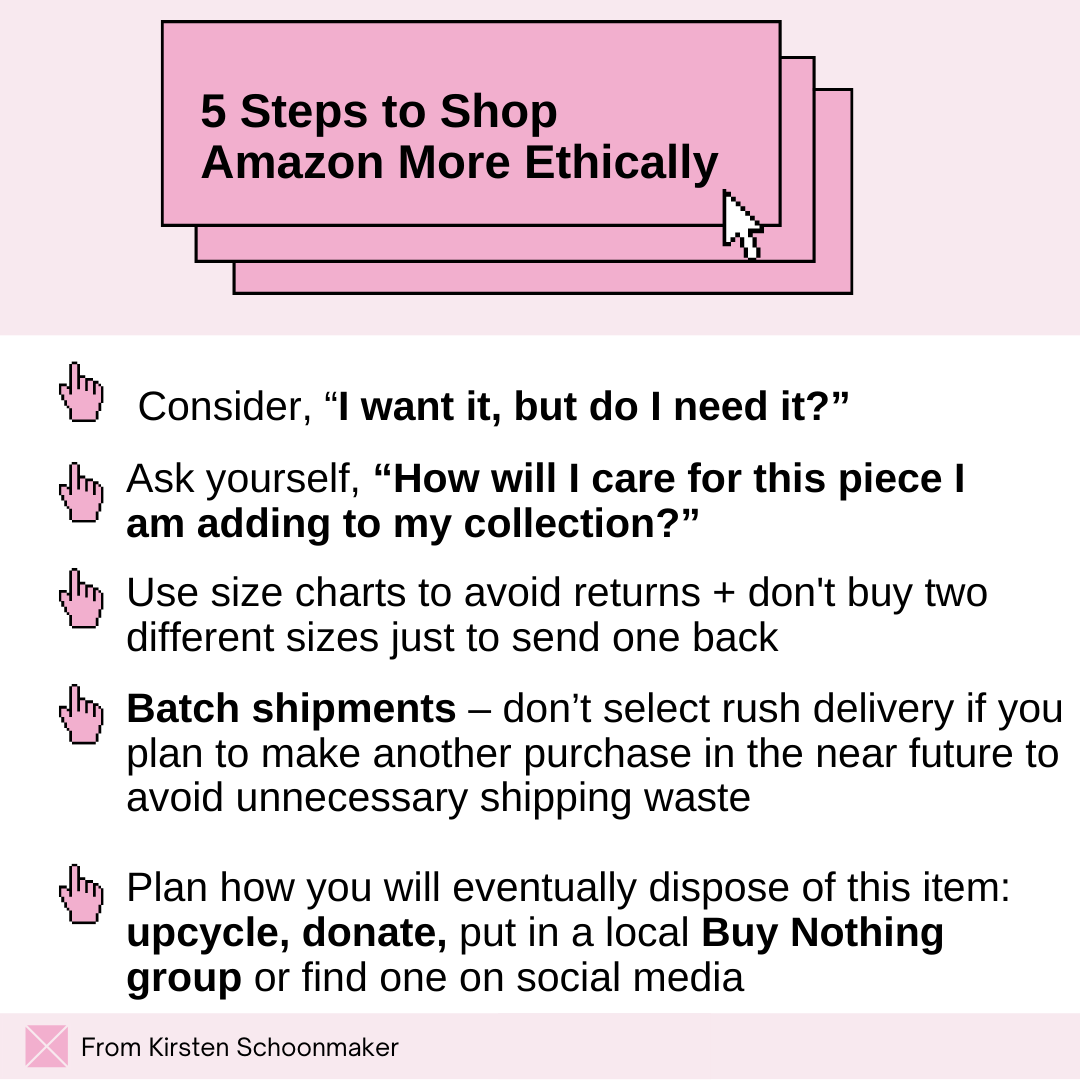Amazon fashion takes over TikTok #FYPs everywhere
Why Amazon fashion is taking over your TikTok #FYP

Working for the same company as the second richest man in the world involves light makeup, a personal tripod, and a few outfit changes. Emma Roof spends every Monday and Wednesday filming fashion TikToks before her classes at the University of South Carolina. Over 3 million likes flood her profile, displaying the tall blonde showcasing her favorite Amazon fashion finds: smiley face slippers, workout sets, pastel claw hair clips, Y2K knits, tiny shoulder bags and chunky, gold jewelry. She dedicates a minimum of two hours to shooting branded content for her 291,900 followers, and Roof’s 30-second videos join the growing content uploaded by hundreds of Amazon Prime influencers whose work creates a powerful intersection between business and social platforms.
The TikTok app and the virality of its content helped fuel Amazon’s popularity in recent months. In fact, TikTok’s current viral hashtags show that users have a lot to say about Amazon and its products. The hashtag “Amazon” boasts 21.7 billion views, with “Amazon Finds” at 14.4 billion, and “Amazon Favorites” at 1.6 billion, as of December 2021. The platform has the most powerful instant feedback loop of all social channels due to its interactive feed, says Shelly Palmer, LinkedIn’s Top Voice in Technology. “There is nothing more effective, more damaging, more dangerous, more insane than TikTok,” says Palmer, who describes Amazon as “a massively powerful creature with acid for blood, that can kill anything it sees.”
The platform’s power resides in its ability to foster relationships between users and brands and thanks to technology, makes those experiences increasingly swift and shoppable, says Jenna Drenten, Loyola University Chicago associate professor of marketing and consumer culture. Features such as click-through links help to streamline the consumer experience, making it feel very seamless, Drenten says. Those forces also fuel trends. “When we define trends, we think, ‘What are the conversations that people are having right now?’” says Chazz Inniss, growth strategist of fashion content partnerships at TikTok. Inniss explains that the digitization of our world has made trends grow faster than before and fostered the growth of digital communities. “TikTok does not position itself as a social media app, but rather, as an entertainment and educational platform that explores the now,” Inniss explains.
Consumers seem to be increasingly interested in exploring Amazon right now. The e-commerce company was first established as an online bookstore in 1994, quickly expanding to music four years later, and opening up to third-party sellers the following year in 1999. In 2002, the company expanded its products to clothing and has since grown as a fashion hub for viral trendsetters. “Amazon is successful and continues to be successful because of the way it has evolved to meet consumer needs. Our business goal is to become the most customer-centric website in the world,” says Taylor Kaplan, Amazon associate account executive. Gen-Z shops Amazon because it is incredibly convenient, the customer service is better than any other e-commerce platform, and the prices are competitive, she explains. More than 72% of Gen-Z female-identifying shoppers turn to Amazon first to discover new beauty and fashion products, according to the 2019 Amazon Consumer Shopping Study of retail-focused ad agency, CPC Strategy.
Kaplan attributes Amazon’s success on the TikTok platform with Gen-Z consumers to their robust influencer network, consisting of hundreds nationwide. Amazon defines its influencers as individuals with meaningful social media followings, who have shoppable Amazon storefronts. Content creators can earn commission on the products they promote while amplifying the Amazon brand. “TikTok corporate has invested massive amounts of money and hiring into growing their strategic brand partnerships and their creator marketplace, so that businesses, like Amazon, can benefit from the platform,” Drenten says. Based on Amazon’s exponentially swift rise on the platform, this strategy seems to be working. Influencer marketing is successful and powerful, especially for Gen-Z, says Corey Takahashi, a magazine, news and digital journalism associate professor at Syracuse University. “I don’t see that waning because younger generations tend to trust someone they see as a peer rather than some godlike voice in a traditional advertisement,” Takahashi says.
@dkapllanialready in the christmas spirit #myprimestudent #fyp @primestudent #amazon #amazonwishlist #christmaswishlist♬ this is our dance give credit lol – kara
Roof says she has watched the Amazon fashion trend grow directly through influencers who promote their own Amazon storefronts, as she does with her TikTok followers. A storefront is a personalized page where individual creators can link items they share on their social media accounts and earn a commission when users shop the products, she explains. Influencers drive more consumers to Amazon and help to frame it as an online clothing store specifically, Roof says. Her personal storefront page has eight curated categories with descriptions including “going-out fits,” “fashion basics,” “must-have accessories,” “unique Christmas gifts,” and more. Each list incorporates elements of the most recent viral fashion trends: sweater vests, neutral-toned matching sets and strappy bodysuits, all of which amount to under $30.
Like Roof, Denada Kapllani is a digital content creator with 36,700 TikTok followers who works as part of the Amazon Prime Student Influencer Program. One of Kapllani’s popular videos features her holiday wishlist made up entirely of Amazon products. A viral TikTok remix of “Here Comes Santa Claus” jingles in the background as products flash across the screen: a golden tube of eyelash serum, followed by multicolored baseball caps, one navy blue and the other hot pink, both with the New York Yankees team emblem embroidered on the front. Next, she displays an oversized varsity jacket, a vegan leather JW PEI handbag and of course, the infamous smiley face slippers. “Linked in bio,” reads a small text bubble on the screen. Another 30-second video from October shows the college student’s Amazon fall fashion finds: brown puffer jackets, graphic sweaters, and black platform boots. “I ran to buy,” says one of the top comments from a follower. Kapllani’s storefront is linked at the top of her TikTok profile. Her followers can purchase directly from Amazon without leaving their own TikTok for-you-pages: a seamless shopping experience that feels irresistible to most.
Social media plays a huge role in Amazon’s fashion marketing, explains Kapllani. Through her own experience, she believes that Instagram and TikTok draw most consumers to Amazon. “Personally, I never knew Amazon had a fashion section. I always thought they just sold random items or electronics, and it wasn’t until recently, through social media, that I found out how many people are now going to Amazon to purchase fashion pieces,” Kapllani says.
While Amazon boasts a network of hundreds of student influencers, many content creators choose not to collaborate with the e-commerce company due to controversy surrounding its labor ethics and fast fashion practices. “Influencers are notorious for this idea of authenticity and that they’re not going to sell out and they’re only going to promote brands that align with their morals and values,” Drenten says. Erin Eagle, style influencer and owner of Instagram accounts inthesejeans and A Style Set, with a combined total following of 114,000, says although she has an Amazon storefront, she chooses not to promote it due to the company’s questionable ethics.
While an influencer on TikTok may be promoting a $19 top, consumers don’t consider that top’s footprint, fuel consumption, and energy use of moving the product at Amazon Prime speed, says Kirsten Schoonmaker, an assistant teaching professor in the fashion design program at Syracuse University, who specializes in the material goods of fashion and contemporary issues in the industry. The quick returns for which Amazon earns praise also contribute to a massive problem, Schoonmaker says. “While Amazon is pushing that they have sustainable materials, it feels like they are glossing over the monumental issue of the shipping catastrophe,” Schoonmaker says.
Average consumers mystify the production of fashion, ignoring the inputs of water, fuel, energy, and fertilizers in different stages of production, Schoonmaker explains. The fast fashion industry continues to be the second most polluting industry in the world. One of the biggest consumers of water and energy is in the hands of the consumer after purchase. Schoonmaker asked, If you buy a $19 top and only wear it twice, what are the impacts of that? “When we talk about Amazon and the idea that you can have things quickly or return without impact, this is what it really looks like,” she says.
Consumers love Amazon fashion for its immediacy and swift adaptation to trends, but its negative ecological impact can be great. Schoonmaker says that from a historical angle, looking at the 18th century, for example, a woman’s wardrobe was her most valuable asset. “We have outsourced our knowledge of how that textile came to be and therefore divorced ourselves from an understanding of that value,” Schoonmaker says in regards to Gen-Z’s current outlook on fast fashion.

Kaplan acknowledges Amazon’s reputation surrounding fast fashion and the concerns that it pushes small businesses off the market, but says that many don’t recognize its efforts to support small creators. “Unless you’re searching for a specific name brand, most sellers on Amazon are small businesses,” she says. Amazon allows them the chance to utilize their platform and get a much larger reach on their products and grow beyond what they can imagine, Kaplan says.
“Not everyone is going to love them. Yes, they definitely can improve, but at the end of the day when you press a button, the next morning, whatever you ordered shows up,” Palmer says.
While creators like Roof and Kapllani assemble their iPhone ring lights in their college apartments and intricately curate their detailed Amazon storefronts, Kaplan says, through its development and influencer network on TikTok, Amazon will always be trending. TikTok is more than a social app and Amazon is more than a for-you-page trend. The intersection of platforms has created a movement among Generation Z and their consumption of media and goods, even if that movement is merely convincing consumers to add viral, smiley face slippers to their online shopping carts.





